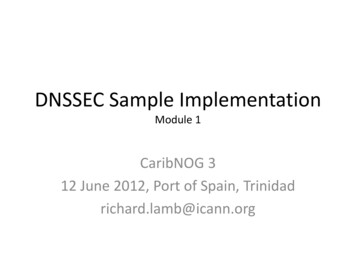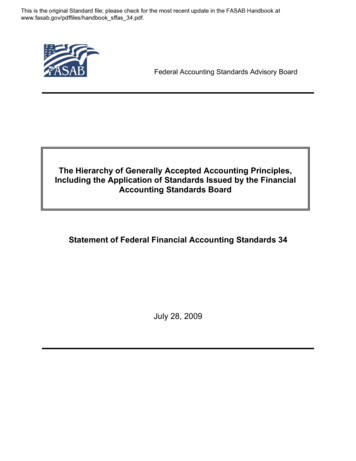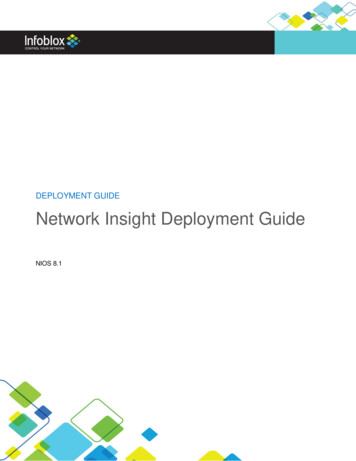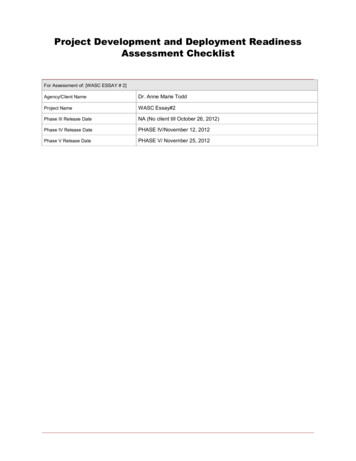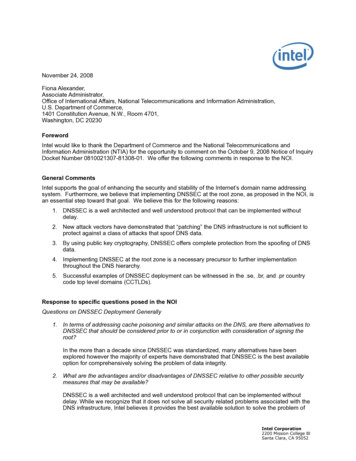
Transcription
November 24, 2008Fiona Alexander,Associate Administrator,Office of International Affairs, National Telecommunications and Information Administration,U.S. Department of Commerce,1401 Constitution Avenue, N.W., Room 4701,Washington, DC 20230ForewordIntel would like to thank the Department of Commerce and the National Telecommunications andInformation Administration (NTIA) for the opportunity to comment on the October 9, 2008 Notice of InquiryDocket Number 0810021307-81308-01. We offer the following comments in response to the NOI.General CommentsIntel supports the goal of enhancing the security and stability of the Internet’s domain name addressingsystem. Furthermore, we believe that implementing DNSSEC at the root zone, as proposed in the NOI, isan essential step toward that goal. We believe this for the following reasons:1. DNSSEC is a well architected and well understood protocol that can be implemented withoutdelay.2. New attack vectors have demonstrated that “patching” the DNS infrastructure is not sufficient toprotect against a class of attacks that spoof DNS data.3. By using public key cryptography, DNSSEC offers complete protection from the spoofing of DNSdata.4. Implementing DNSSEC at the root zone is a necessary precursor to further implementationthroughout the DNS hierarchy.5. Successful examples of DNSSEC deployment can be witnessed in the .se, .br, and .pr countrycode top level domains (CCTLDs).Response to specific questions posed in the NOIQuestions on DNSSEC Deployment Generally1. In terms of addressing cache poisoning and similar attacks on the DNS, are there alternatives toDNSSEC that should be considered prior to or in conjunction with consideration of signing theroot?In the more than a decade since DNSSEC was standardized, many alternatives have beenexplored however the majority of experts have demonstrated that DNSSEC is the best availableoption for comprehensively solving the problem of data integrity.2. What are the advantages and/or disadvantages of DNSSEC relative to other possible securitymeasures that may be available?DNSSEC is a well architected and well understood protocol that can be implemented withoutdelay. While we recognize that it does not solve all security related problems associated with theDNS infrastructure, Intel believes it provides the best available solution to solve the problem ofIntel Corporation2200 Mission College BlSanta Clara, CA 95052
the data integrity in the DNS and we should not delay the implementation of DNSSEC at the rootzone for these reasons.We note that some deployment issues such as DNSSEC's complexity, increase in size forresponse packets, potential performance tradeoffs and response time increases due to signaturevalidation or complications created by the use of the hierarchical trust model may exist andshould be addressed in a timely fashion by stakeholders and implementers.3. What factors impede widespread deployment of DNSSEC?Widespread deployment of DNSSEC is currently impeded by the fact that DNSSEC is notcurrently implemented at the root zone level. Other implementers of DNSSEC cannot realize thesecurity benefits of DNSSEC signing their zones absent a signed root zone.4. What additional steps are required to facilitate broader DNSSEC deployment and use?The domain name service industry has to fully implement DNSSEC and the Internet communitymust work together to standardize the response to invalid DNS responses.5. What end user education may be required to ensure that end users possess the ability to utilizeand benefit from DNSSEC?No direct end user education is needed; DNSSEC should be a transparent process to the enduser.As noted above, Intel recognizes the need for the Internet community to standardize theinformation that the end user is presented with in the event of invalid DNS responses.General Questions Concerning Signing of the Root Zone1. Should DNSSEC be implemented at the root zone level? Why or why not?Intel supports implementation DNSSEC at the root zone level because it provides wellunderstood and well tested solution to the very immediate problem of the integrity of DNS data.2. What is a viable time frame for implementation at the root zone level?Intel supports immediate implementation of DNSSEC at the root zone and we believe that ICANNis best positioned to achieve this.3. What are the risks and/or benefits of implementing DNSSEC at the root zone level?The obvious risk to DNSSEC, or any other public key cryptography solution, is a potentialcompromise of the keys that are used to sign the root. However, we feel strongly that the benefitof protecting the integrity of the DNS from a class of attacks that that fundamentally underminethe integrity of DNS data outweighs the risk of compromised keys. Furthermore, we believe thatan effective method can be implemented to protect the keys and thus significantly reducing themain risk associated with DNSSEC.4. Is additional testing necessary to assure that deployment of DNSSEC at the root will notadversely impact the security and stability of the DNS? If so, what type of operational testingshould be required, and under what conditions and parameters should such testing occur? Whatentities (e.g., root server operators, registrars, registries, TLD operators, ISPs, end users) shouldbe involved in such testing?Intel Corporation2200 Mission College BlSanta Clara, CA 95052
Intel does not believe that any additional testing is necessary as DNSSEC has been an IETFstandard for more than a decade. Numerous testbeds have been in operation for sometime asreferenced on the IETF’s website 1: The Secure Naming Infrastructure Pilot (SNIP) - A joint project involving NIST,SPARTA Inc, and the Dept. of Homeland SecurityDNSSEC test deployment at IANAPublic Interest Registry (PIR) Testbed - Testbed for the .org domainNominet UK DNSSEC Testbed - DNSSEC Testbed for the .uk domain (co.uk, org.uk,net.uk, ltd.uk, plc.uk, me.uk and sch.uk)DNSSEC testbed in Russia (.ru) - Includes signed view, as well as securedelegationsDNSSEC Deployment in Puerto Rico (.pr) -Real DNSSEC Deployment for the .prccTLDDNSSEC testbed in Mexico (.mx) - DNSSEC testbed for the .mx ccTLDCZ.NIC Testbed - Testbed for the .cz ccTLDNLnet Labs SECREG TestbedDNSSEC testbed in the Netherlands (.nl) (no longer active) - NIC-SE / IIS DNSSECDeployment in Sweden (.se)Register.BG DNSSEC Deployment - DNSSEC in Bulgaria (.bg)Registro.BR DNSSEC Deployment - DNSSEC in Brasil (.br)DLV Registry (DNSSEC Look-aside Validation) at ISC - DLV is a technology initiativemeant to enable DNSSEC deploymentComcast DNSSEC Trial - DNSSEC-capable resolver at Comcast to test against.Root Server Testbed Network - Coordinated, persistent facility to evaluate majorchanges to the DNSVerisign Opt-In DNSSEC Pilot - DNSSEC Opt-In testbed (deprecated)University of Murcia DNSSEC testbed (SEINIT) - Partners: Alcatel, BT, DeutscheTelekom, et alMYNIC DNSSEC Deployment (.my ccTLD) - DNSSEC Deployment in Malaysia5. How would implementation of DNSSEC at the root zone impact DNSSEC deployment throughoutthe DNS hierarchy?Implementing DNSSEC at the root zone is a necessary precursor to further implementationthroughout the DNS hierarchy.6. How would the different entities (e.g., root operators, registrars, registries, registrants, ISPs,software vendors, end users) be affected by deployment of DNSSEC at the root level? Are thesedifferent entities prepared for DNSSEC at the root zone level and /or are each consideringdeployment in their respective zones?While we cannot predict how DNSSEC might affect every possible stakeholder, we are unawareof any adverse affect to zone operators who choose not to implement DNSSEC at this time. Wealso note that some entities around the world are ready or have already deployed DNSSEC.Operational Questions Concerning Signing of the Root Zone1. The Department recognizes that the six process flow models discussed in the appendix may notrepresent all of the possibilities available. The Department invites comment on these process flowmodels as well as whether other process flow model(s) may exist that would implementdeployment of DNSSEC at the root zone more efficiently or effectively.After reviewing all process flow models proposed in the NOI, Intel supports process flow model 4as we believe it provides the most logical solution to the question of implementation. However,we do not see the need for a separate root zone distributor as shown in the diagram because1http://www.dnssec.net/projectsIntel Corporation2200 Mission College BlSanta Clara, CA 95052
there is no functional or technical need to have the signed root zone file distributed by anadditional entity. We believe having a model that includes an additional entity presents anotherpoint of failure which is unnecessary for the process to be completed.Intel believes that process flows 1,2,3 and 5 as presented in the NOI unnecessarily complicatethe process of signing the root and introduce additional points of weakness where the system canbe attacked. We believe that minimizing the points of failure in the model is the best way toensure the security and stability of the DNS. Furthermore we believe that ICANN, in implementingthe IANA functions, has demonstrated the expertise to execute this process. They are the onlyentity in the process that can validate the information as they receive the information from theTLD operator. Process flow models 1,2,3 and 5 reduce the IANA function to merely relayinginformation from one entity to another and places all the technical functions in the hands of a rootzone maintainer and/or key operator who does not have the relationships or knowledgenecessary to determine whether the information is correct. These models are unnecessarilycomplex and allow for too many points of failure from the issuance of a change request todistribution of the zone file.With regard to process flow model 6, Intel finds that it also presents an unnecessarily complexsolution. Furthermore, like process flows 1,2,3 and 5, process flow 6 separates the function ofsigning the root from the entity who receives the zone information.The application of the zone signing key (ZSK) and the generation of the key signing key (KSK)should not be an overly complicated process. The issue of primary importance is the invalidationof the KSK and all six proposals fail to address the important issue of KSK invalidation. It iscritical that this issue be addressed as it fundamentally affects the architecture of the system.Intel strongly supports a model in which multiple entities come together to invalidate the ZSK.2. Of the six process flow models or others not presented, which provides the greatest benefits withthe fewest risks for signing the root and why?Process flow 4 for the above stated reasons.3. Specifically, how should key management (public and private key sets) be distributed and why?What other factors related to key management (e.g., key roll over, security, key signing) need tobe considered and how best should they be approached?Intel supports a model in which the function of generating both the ZSK and KSK sits in IANAoperator who has the knowledge that the data is correct as they receive the information. Therollover of the ZSK should be a frequent occurrence and therefore that responsibility should alsorest in the IANA function.KSKs must be generated at the time of initial implementation. While the NOI doesn’t cover thisarea specifically, Intel believes it will be prudent to generate a fixed and relatively small number ofKSKs initially. The process of invalidating and rolling over between the limited number of KSKsshould be made by a consensus group (of more than one member) in a public way. We believethis group should be comprised of multiple entities with expertise in DNSSEC, cryptography andsecurity.4. We invite comment with respect to what technical capabilities and facilities or other attributes arenecessary to be a Root Key Operator.Intel believe that the most important qualification is that the root key operator must be the directand authoritative holder of the knowledge regarding the correctness of the data. Furthermore, theentity must demonstrate the ability to follow the IETF standard RFC 4641, September 2006 –“DNSSEC Operational Practices”. Intel supports ICANN in fulfilling this function as they possessboth the data and because they have demonstrated through their ability to implement DNSSEC.Intel Corporation2200 Mission College BlSanta Clara, CA 95052
5. What specific security considerations for key handling need to be taken into account? What arethe best practices, if any, for secure key handling?Suggested reference the IETF standard RFC 4641, September 2006 – “DNSSEC OperationalPractices”.6. Should a multi-signature technique, as represented in the M of N approach discussed in theappendix, be utilized in implementation of DNSSEC at the root zone level? Why or why not? If so,would additional testing of the technique be required in advance of implementation?Intel believes that process flow 6 presents an overly complex model for maintaining the ZSK.However, Intel fully supports a similar technique for the process of invalidating the KSK in theevent of compromise. We believe that multiple entities should be required to come together inorder to invalidate the KSK.Intel Corporation2200 Mission College BlSanta Clara, CA 95052
information that the end user is presented with in the event of invalid DNS responses. General Questions Concerning Signing of the Root Zone 1. Should DNSSEC be implemented at the root zone level? Why or why not? Intel supports implementation DNSSEC at the root zone level because it provides well
